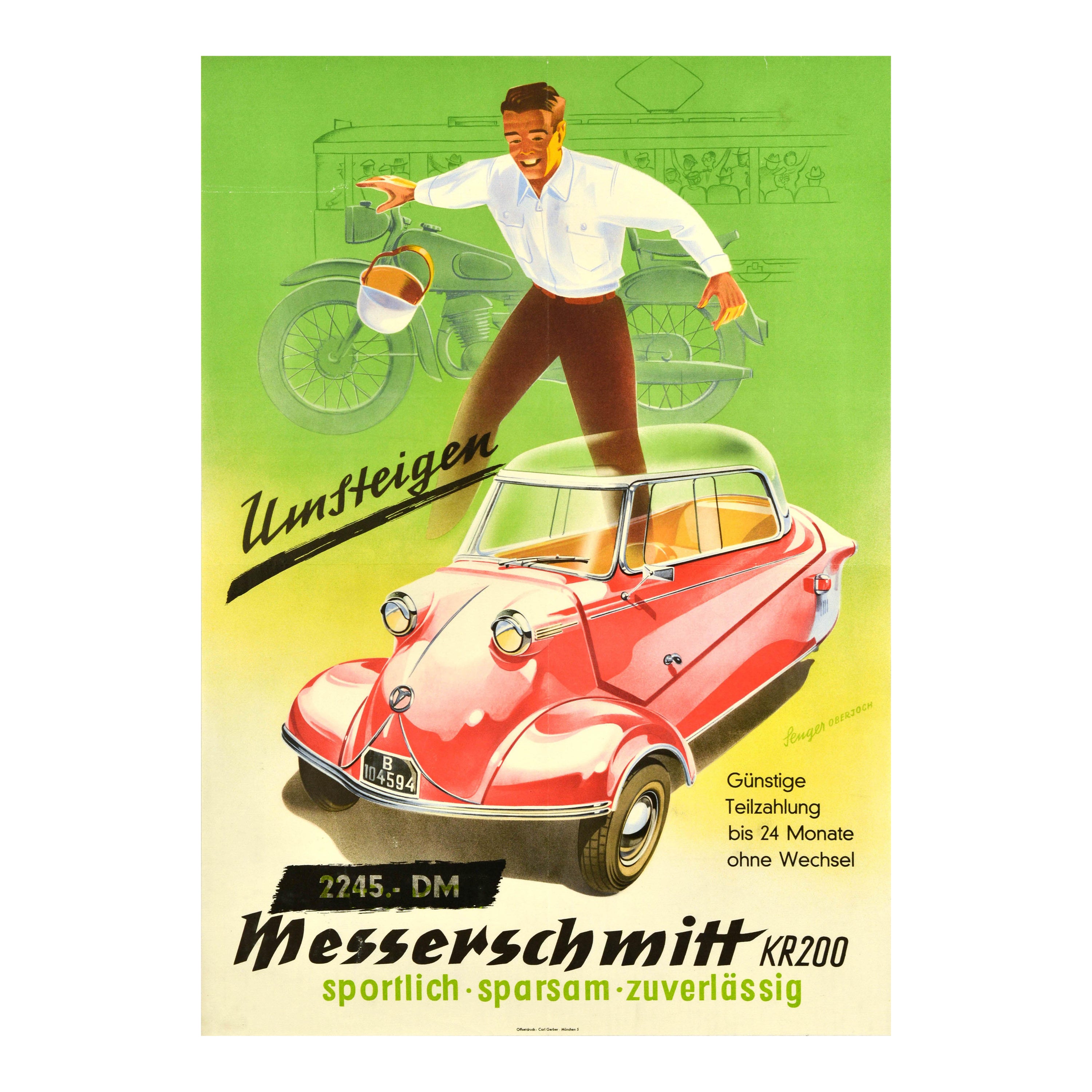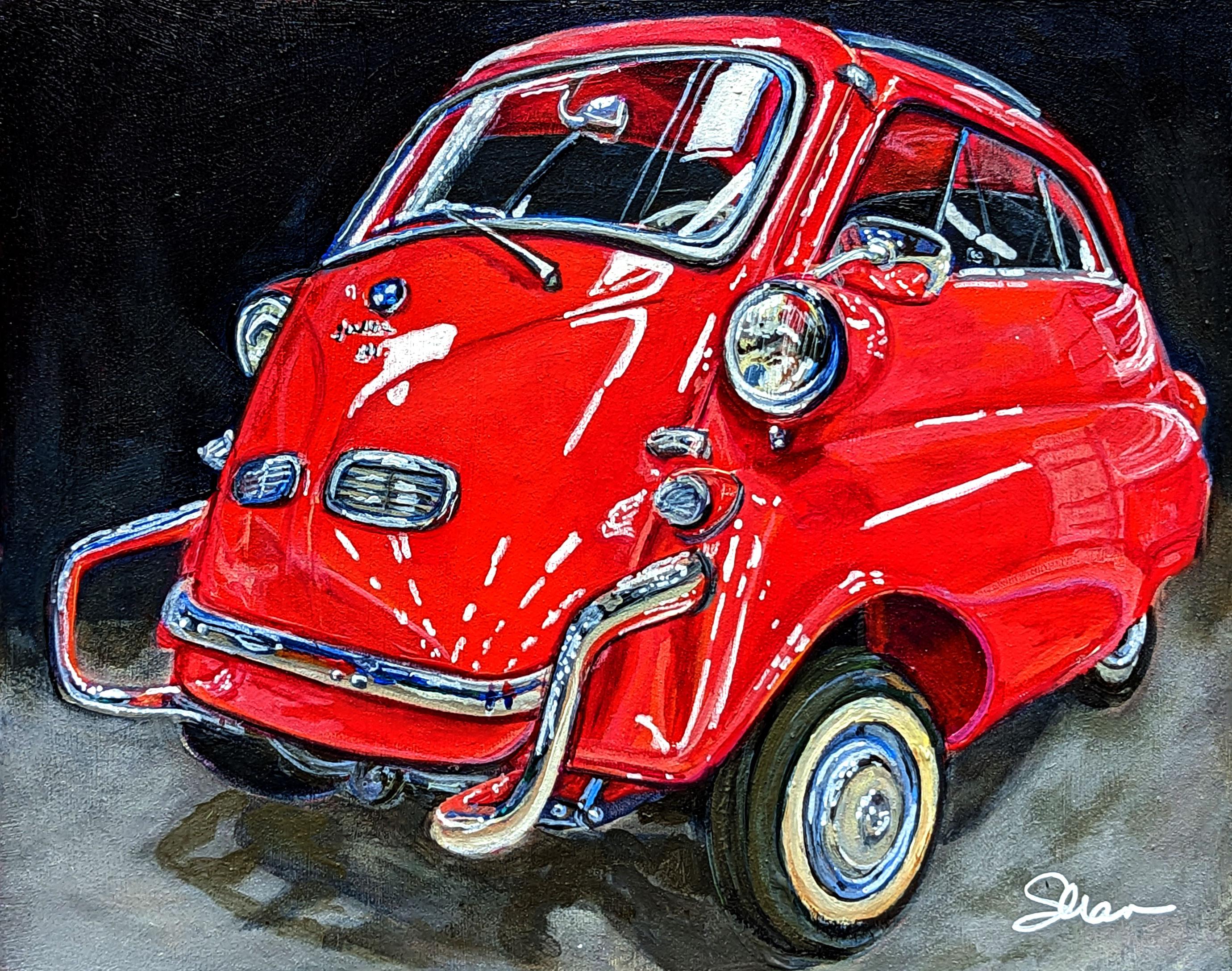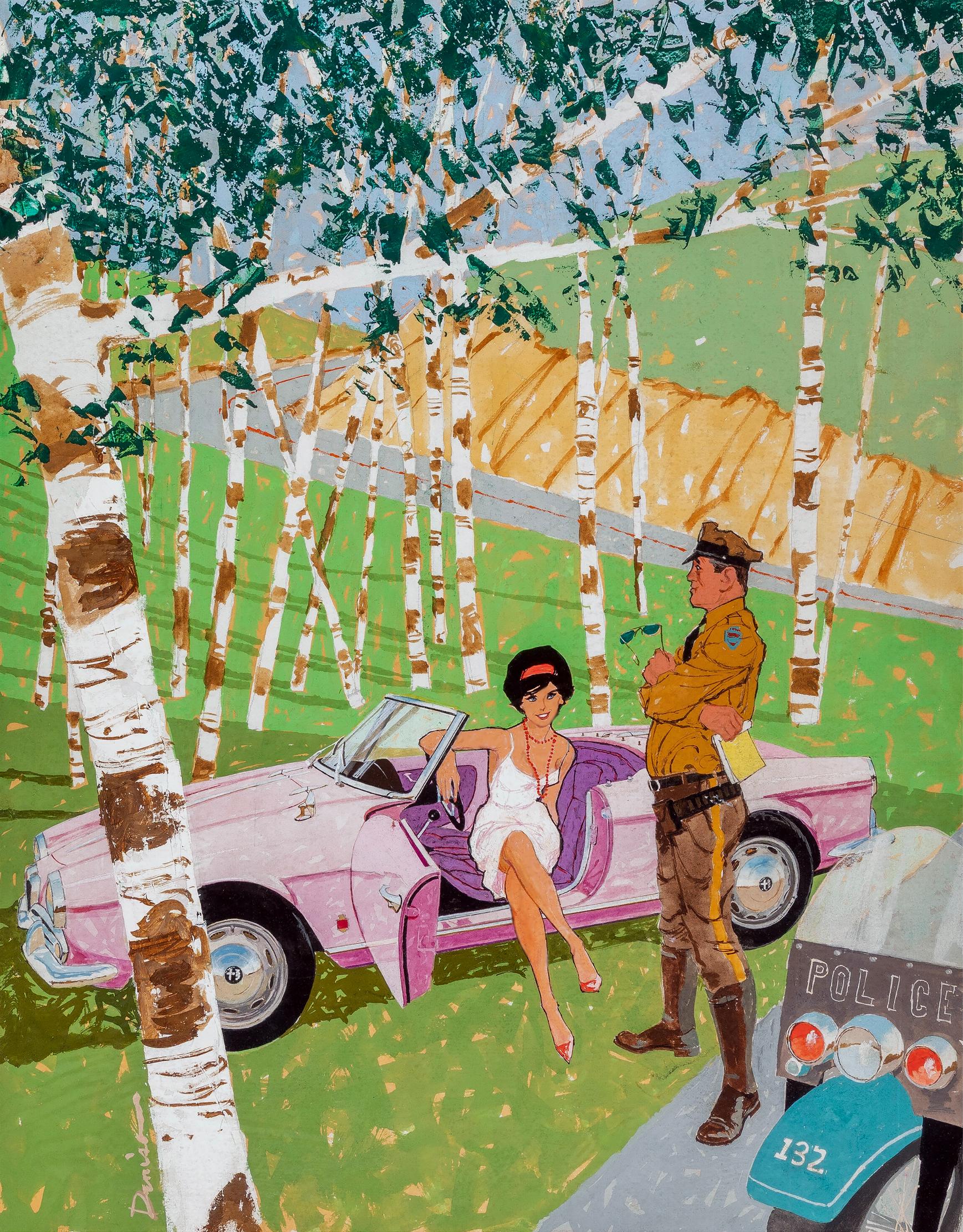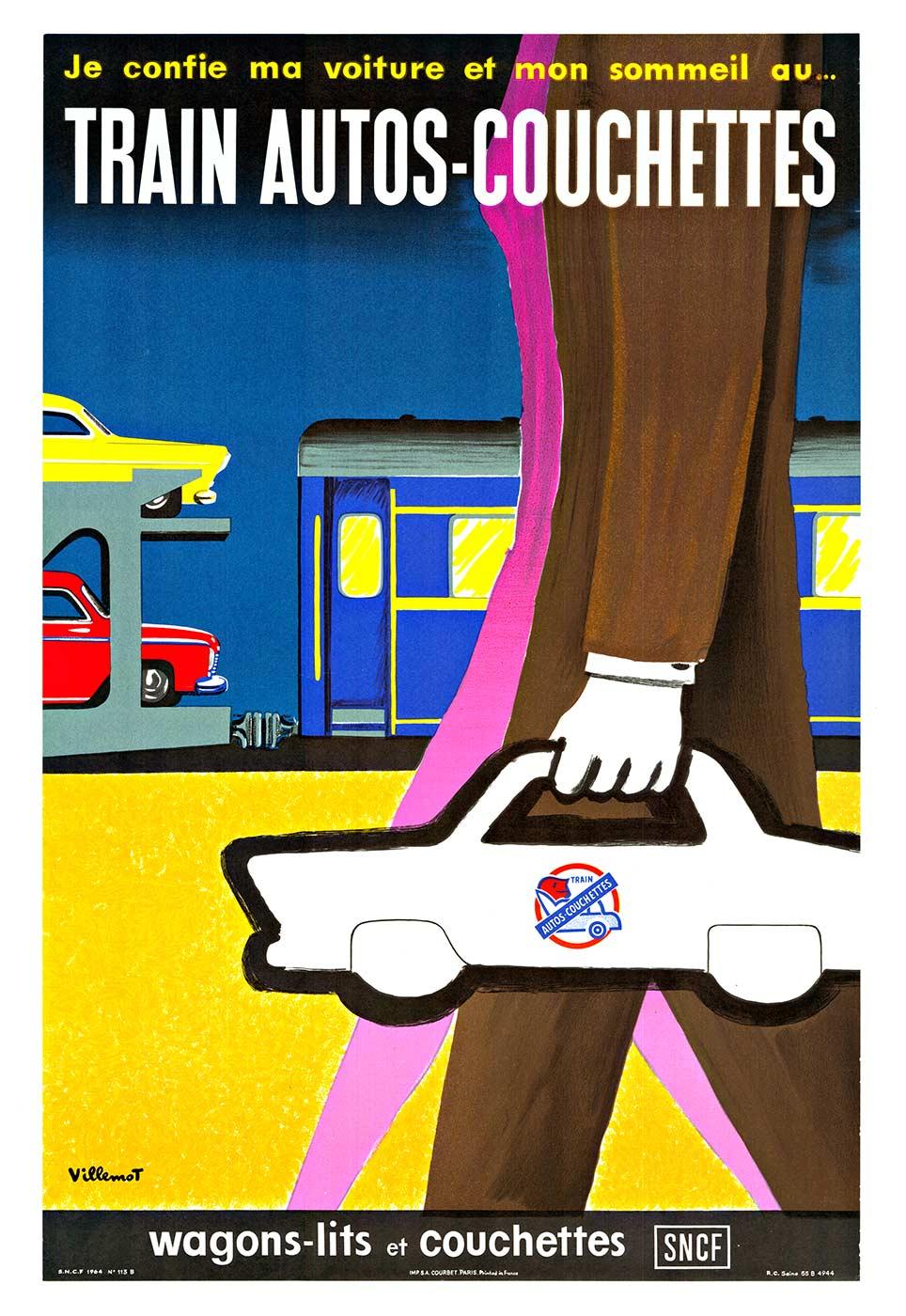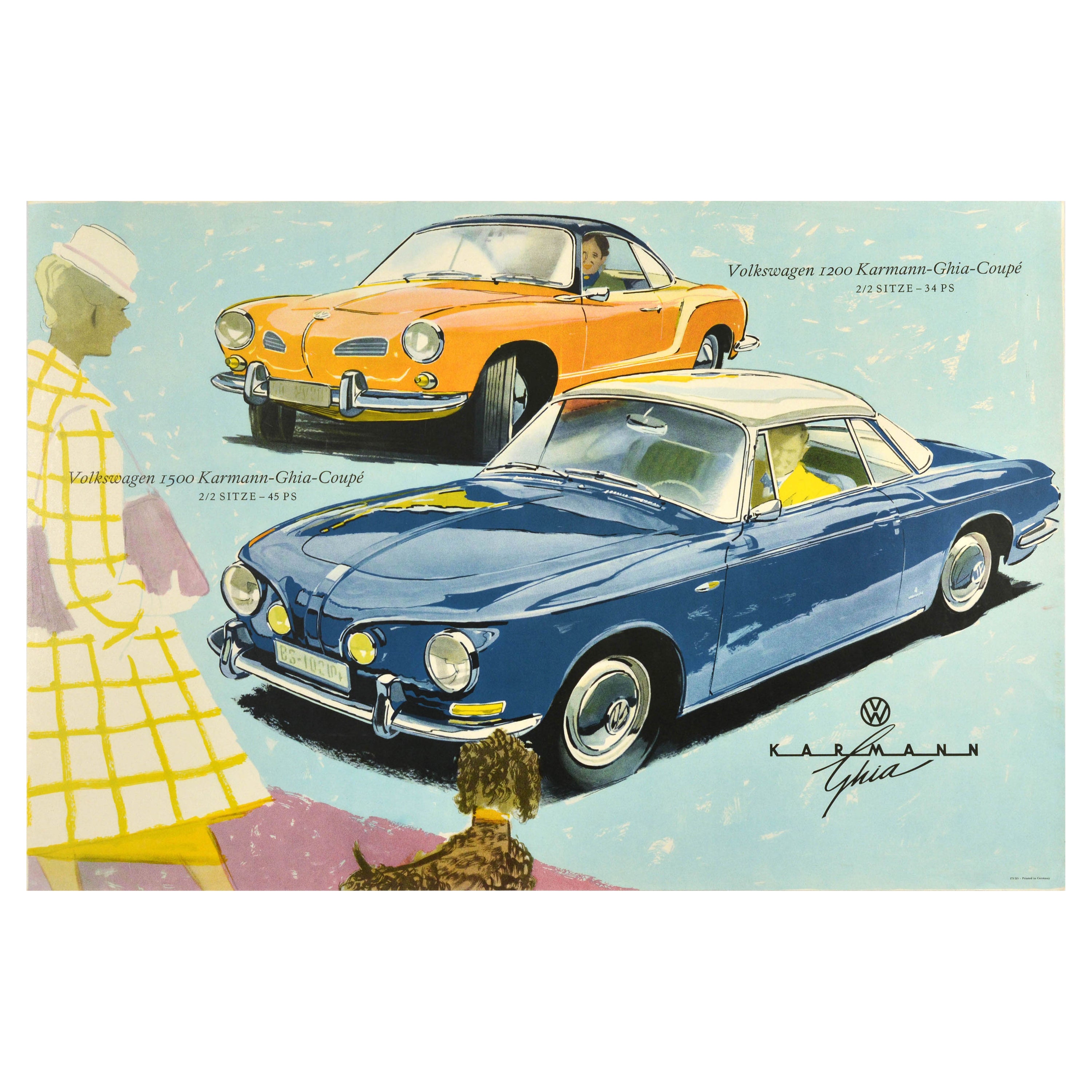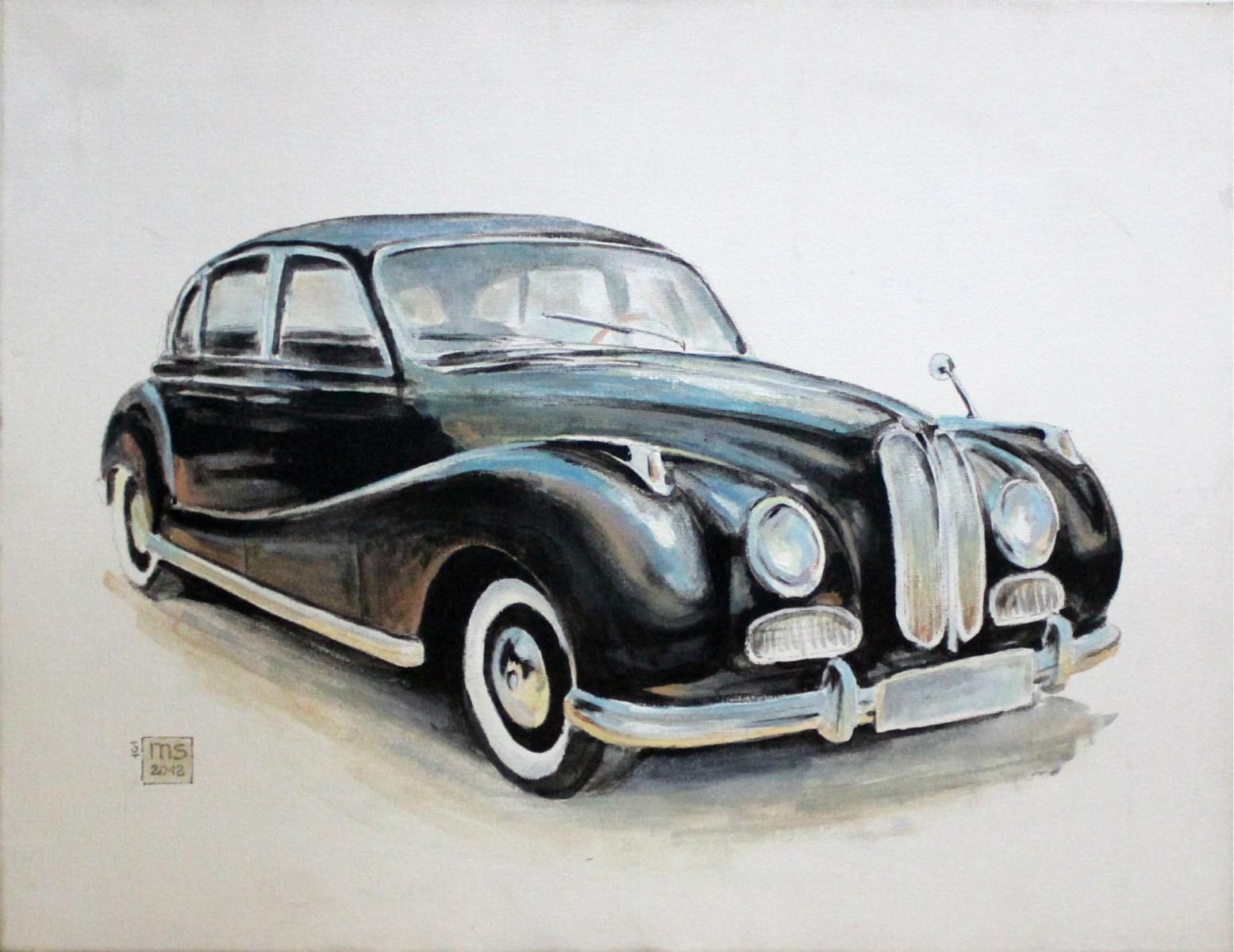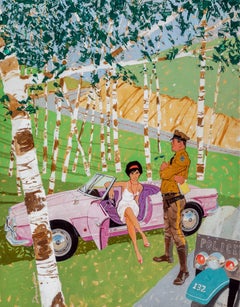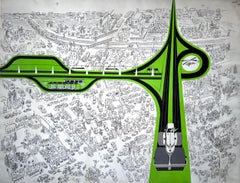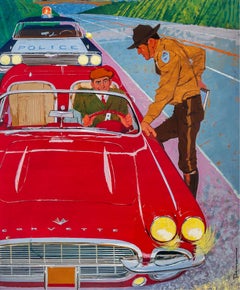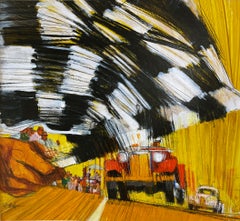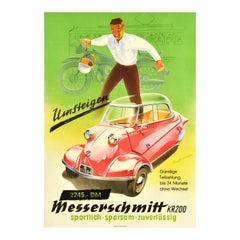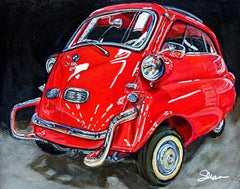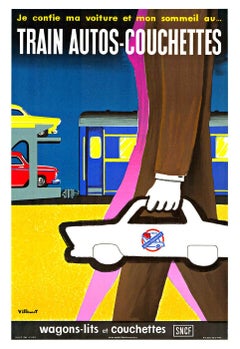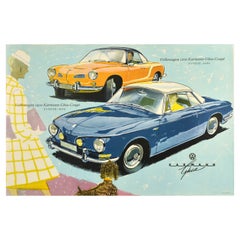Items Similar to BMW Isetta, Messerschmitt Cars Autobahn - Humorous Mid-Century Illustration
Video Loading
Want more images or videos?
Request additional images or videos from the seller
1 of 11
Richard ErdoesBMW Isetta, Messerschmitt Cars Autobahn - Humorous Mid-Century Illustration1955
1955
$6,000
£4,531.82
€5,237.48
CA$8,415.92
A$9,360.66
CHF 4,899.17
MX$114,169.21
NOK 61,559.86
SEK 57,904.99
DKK 39,092.72
About the Item
One of the hallmarks of great art is recognizing the artist's style instantly. This is the case with Richard Erdoes. His highly stylized comic figures are expressive and communicate the story delightfully and joyfully. Even though this work is rendered in flat, minimalistic two colors, the inventive shape relationships and positive and negative areas convey a very high level of artistic skill. The present work was done on assignment for the prestigious Standard Oil ( Exxon's predecessor ) corporation's company magazine, The Lamp. Although not a newstand magazine, The Lamp had the highest editional and artistic content. Work is unsigned and unframed.
Richard Erdoes (Hungarian Erdős, German Erdös; July 7, 1912 – July 16, 2008) was an American artist, photographer, illustrator and author.
Early life
Erdoes was born in Frankfurt,to Maria Josefa Schrom on July 7, 1912. His father, Richárd Erdős Sr., was a Jewish Hungarian opera singer who had died a few weeks earlier in Budapest on June 9, 1912.After his birth, his mother lived with her sister, the Viennese actress Leopoldine ("Poldi") Sangora,He described himself as "equal parts Austrian, Hungarian and German, as well as equal parts Catholic, Protestant and Jew..."[4]
Career
He was a student at the Berlin Academy of Art in 1933, when Adolf Hitler came to power. He was involved in a small underground paper where he published anti-Hitler political cartoons which attracted the attention of the Nazi regime. He fled Germany with a price on his head. Back in Vienna, he continued his training at the Kunstgewerbeschule, now the University of Applied Arts, Vienna.[5] He also wrote and illustrated children's books and worked as a caricaturist for Tag and Stunde, anti-Nazi newspapers. After the Anschluss of Austria in 1938 he fled again, first to Paris, where he studied at the Academie de la Grande Chaumiere, and then London, England before journeying to the United States. He married his first wife, fellow artist Elsie Schulhof (d. xxxx) in London, shortly before their arrival in New York City.
In New York City, Erdoes enjoyed a long career as a commercial artist, and was known for his highly detailed, whimsical drawings. He created illustrations for such magazines as Stage, Fortune, Pageant, Gourmet, Harper's Bazaar, Sports Illustrated, The New York Times, Time, National Geographic and Life Magazine, where he met his second wife, Jean Sternbergh (d. 1995) who was an art director there. The couple married in 1951 and had three children.[6] Erdoes also illustrated many children's books.
An assignment for Life in 1967 took Erdoes to the Pine Ridge Indian Reservation for the first time, and marked the beginning of the work for which he would be best known. Erdoes was fascinated by Native American culture, outraged at the conditions on the reservation and deeply moved by the Civil Rights Movement that was raging at the time. He wrote histories, collections of Native American stories and myths, and wrote about such voices of the Native American Renaissance as Leonard and Mary Crow Dog and John Fire Lame Deer.[7] The Erdoes' New York City apartment was a well known hub of the American Indian Movement (AIM) in the early 1970sand he became involved in the legal defense of several AIM members.[citation needed] In 1975 the family moved to Santa Fe, New Mexico where Erdoes continued to write and remained active in the movement for Native American civil rights.
His papers are preserved at the Beinecke Rare Book and Manuscript Library at Yale University.[8]
Works
As author:
Peddlers and Vendors Around the World (1967)
Policemen Around the World (1967)
Musicians Around the World (1971)
The Sun Dance People: The Plains Indians, Their Past and Present (1972)
The Rain Dance People: The Pueblo Indians, Their Past and Present (1976)
The Woman Who Dared (1978)
Saloons of the Old West (1979)
The Native Americans: Navajos (1979)
Native Americans: The Sioux (1982)
Native Americans: The Pueblos (1983)
The Richard Erdoes Illustrated Treasury of Classic Unlaundered Limericks (1984) I
A.D. 1000: Living on the Brink of Apocalypse (1988)
Crying for a Dream: The World through Native American Eyes (1990)
Tales from the American Frontier (1992) ISSN 0362-8930
Legends and Tales of the American West (1998) I
As illustrator:
The Cat and The Devil (1964) by James Joyce
Come over to My House (1966) by Theo. LeSieg (pen name of Theo Geisel aka Dr. Seuss)[
The Spotted Stones (1978) by Silvio Bedini
- Creator:Richard Erdoes (1912 - 2008, American)
- Creation Year:1955
- Dimensions:Height: 8.25 in (20.96 cm)Width: 10.5 in (26.67 cm)
- Medium:
- Movement & Style:
- Period:
- Condition:Overall good condition, some surface discoloration and scuffs mostly visible only on close inspections. Looks better in person.
- Gallery Location:Miami, FL
- Reference Number:1stDibs: LU385315790372

About the Seller
4.9
Gold Seller
Premium sellers maintaining a 4.3+ rating and 24-hour response times
Established in 2005
1stDibs seller since 2016
117 sales on 1stDibs
Typical response time: 1 hour
- ShippingRetrieving quote...Shipping from: Miami, FL
- Return Policy
Authenticity Guarantee
In the unlikely event there’s an issue with an item’s authenticity, contact us within 1 year for a full refund. DetailsMoney-Back Guarantee
If your item is not as described, is damaged in transit, or does not arrive, contact us within 7 days for a full refund. Details24-Hour Cancellation
You have a 24-hour grace period in which to reconsider your purchase, with no questions asked.Vetted Professional Sellers
Our world-class sellers must adhere to strict standards for service and quality, maintaining the integrity of our listings.Price-Match Guarantee
If you find that a seller listed the same item for a lower price elsewhere, we’ll match it.Trusted Global Delivery
Our best-in-class carrier network provides specialized shipping options worldwide, including custom delivery.More From This Seller
View AllAlfa Romeo Traffic Stop - Playboy Cartoon - Mid Century
Located in Miami, FL
The enduring appeal of Ben Denison's work is not what would be considered corny men's magazine humor of the early 1960s, but rather his masterful painting skills. In the present wor...
Category
1960s Modern Landscape Paintings
Materials
Gouache, Board, Pencil
Mid Century Expressway Proposal Over Norman Rockwell Town
Located in Miami, FL
Artist Richard Erdoes is as undervalued as he is overlooked.
Rarely does an artwork come on that market that combines sharp-witted originality with mind-boggling technical proficiency.
In “Mid-Century Expressway,” Erodes painstakingly draws a birds-eye view of a Norman Rockwell-like town buzzing with activity. He paints far away and close up in one image. Each block has its own charming Americana story unfolding. The closer the viewer gets to each scene, the more detail is revealed.
In black and white, the artist describes not only the architecture and infrastructure but also human activity - lot's of it.
Erodes’s congested town is humming. Overflowing trains, packed busses, zooming cars, stuffed trucks, frenzied pedestrians and even a marching band is depicted with great whit. But do not worry. Progress is coming and all will be well.
Superimposed onto this black and white clogged urban scene is a proposed new highway. It's painted in a punchy green and creates an unexpectedly distinct design.
The artwork was most likely done for Fortune Magazine or the like.
Notice he Esso Gasoline signs...
Category
1950s Minimalist Landscape Paintings
Materials
Paper, Ink, Gouache, Pen
Red Corvette, Hot Car - Playboy Cartoon - Mid-Century
Located in Miami, FL
The cop admires the car while the viewer admires the drawing of the car.
The enduring legacy of Ben Denison may not be that he was an early cartoonist for Playboy, but for his style...
Category
1960s Mixed Media
Materials
Mixed Media, Gouache, Illustration Board
Motorsport Car Racing with Checkered Flag at Finish Line of a Race Track
By Bob Peak
Located in Miami, FL
This highly innovated Bob Peak Race Track painting is a perfect synthesis of art and commerce. Designed with a radical composition where two-thirds of the picture plane is an alm...
Category
1960s Abstract Impressionist Landscape Paintings
Materials
Acrylic, Mixed Media, Illustration Board, Pencil
Heavy Hauler - Mid-Century Illustration - Children's Books
By Art Seiden
Located in Miami, FL
Art Seiden was born in Brooklyn, NY in 1923. He received a BA at Queens College and studied for eight years (!) at the Art Students League. Mario Cooper was among his instructors. Up...
Category
1950s American Modern Figurative Drawings and Watercolors
Materials
Watercolor, Pencil
That's a Wrap, Playboy cartoon Illustration ,
By Dink Siegel
Located in Miami, FL
Dink Siegel (American, 1910-2003)
That's a Wrap, Playboy cartoon, August 1973
Mixed media on board
11.25 x 8.5 in.
Signed lower right
Category
1970s American Modern Figurative Drawings and Watercolors
Materials
Mixed Media
You May Also Like
Original Vintage Car Advertising Poster Messerschmitt KR200 Kabinenroller Auto
Located in London, GB
Original vintage car advertising poster - Umsteigen Messerschmitt KR200 sportlich sparsam zuverlassig Gunstige Teilzahlung bis 24 Monate ohne Wechsel / Switch to Messerschmitt KR200 ...
Category
Vintage 1950s German Posters
Materials
Paper
"1959 Red BMW Isetta 300" (2022) By Shan Fannin, Original Acrylic Painting
By Shan Fannin
Located in Denver, CO
Shan Fannin's (US based) "1959 Red BMW Isetta 300" is an acrylic painting that depicts a red 1959 Red BMW Isetta 300.
Born 1969 in California, artist Shannon “Shan” Fannin brings v...
Category
2010s Photorealist Figurative Paintings
Materials
Acrylic, Wood, Board
Original Train Autos-Couchettes vintage French poster 1964 linen backed
By Bernard Villemot
Located in Spokane, WA
Original 1964 Bernard Villemot Poster — SNCF “I Entrust My Car and My Sleep to …” — Linen Backed Vintage Travel Advertising Art. Fine condition, Grade A. Excellent colors and rea...
Category
1960s American Modern Landscape Prints
Materials
Lithograph
Original Vintage VW Car Advertising Poster Volkswagen Karmann Ghia Automobile
Located in London, GB
Original vintage VW advertising poster for Volkswagen Karmann Ghia cars featuring an illustration of an elegant lady with a dog looking at smiling driver...
Category
Vintage 1950s German Posters
Materials
Paper
BMW 502 (1954)- XXI Century, Contemporary Acrylic Painting, Vehicle, Car
By Mariusz Szałajdewicz
Located in Warsaw, PL
Mariusz Szalajdewicz (b. 1974)
Studied at the Faculty of Architecture at Warsaw University of Technology, where he mastered the drawing skill. Architect and urbanist, illustrator.
Category
21st Century and Contemporary Realist Figurative Drawings and Watercolors
Materials
Canvas, Acrylic
Original Vintage Car Advertising Poster Volkswagen Limousine VW Automobile Retro
Located in London, GB
Original vintage Volkswagen car advertising poster - VW Limousine - featuring images of the car in different colours including black, pale blue, ruby red and pearl white with a note ...
Category
Vintage 1950s German Posters
Materials
Paper
More Ways To Browse
Dior Illustration
1950 Illustration
Nazi Art
Catholic Art
Political Illustrations
Children Book Illustrations
Vintage Illustration Children
Jewish Mid Century Art
Cat Mid Century Art
Dior Car
Cartoon Illustration
Indian Pencil
Cat Illustration
Catholic Books
Vintage German Newspaper
Hungarian Pencil
Vintage Car Drawing
Mid Century Painting Cats
